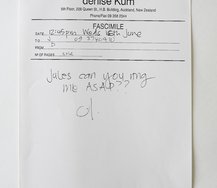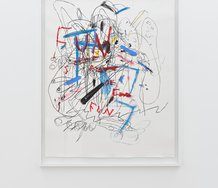John Hurrell – 18 September, 2019
Along the suspended bow, Chan presents a repertoire of three knots: Caisson; Endless; and Button. They serve as glyphs or tied ‘pictographs', discrete entities but in a row—rather than a sequence of words in a sentence that effect each other as you read. Nevertheless, collectively, their meaning coheres.
Part of last year’s emerging artists’ show at Artspace Aotearoa, and now doing an exhibition at Window, Wai Ching Chan continues to show her interest in using Chinese knots to build a symbolic rope bridge of goodwill between Māori and Chinese cultures.
In the University library foyer site—against a backdrop of an olive green tarpaulin—she presents an inverted arc (a wide bowl-like horizontal parabola) of knotted rope that unravels in the centre so that eight thinner (also knotted) lines descend vertically. Two very different cultures that symbolically are fastened to the widely separated left and right ends, meet in the middle.
Along the suspended bow, Chan presents a repertoire of three knots: Caisson; Endless; and Button. They serve as glyphs or tied ‘pictographs’, discrete entities but in a row—rather than a sequence of words in a sentence that effect each other as you read. Nevertheless, collectively, their meaning coheres.
For Chan these knots symbolise the interweaving of cultures that co-exist in close proximity, and which bear each other good will—in particular, tangata whenua and tauiwi / Māori and nonMāori. Here the Chinese component represents nonMāori, more than just a single race. With that the Caisson, Endless and Button knots signify connections within each community and its ethical responsibilities to the wider world; social links blessed by friendship, family and good luck; and the inevitability of these uniting bonding relationships.
The twisting and winding piece of rope as a configuring material seems to symbolically reflects the flexibility and suppleness of the two communities as —in a world of mindless searing conflict—they strive to attain a benevolent interaction, those compact sinewy buckled ‘bumps’ on the hanging line representing mutual admiration and love. Kaitiakitanga, whakawhanaungatanga and kotahitanga, shoulder to shoulder in support.
John Hurrell

 Two Rooms presents a program of residencies and projects
Two Rooms presents a program of residencies and projects Advertising in this column
Advertising in this column



This Discussion has 0 comments.
Comment
Participate
Register to Participate.
Sign in
Sign in to an existing account.